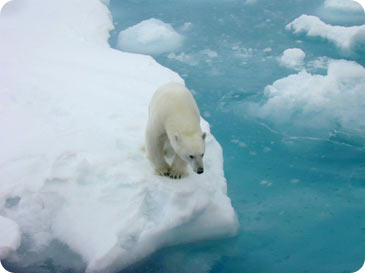How do you make a polar bear float? Mix two scoops of polar bear with a bottle of root beer!
Okay, so that’s basically just another bad joke from the Internet. But it does give us a chance to talk about how polar bears and other creatures manage to stay afloat in the water.
For the polar bear, it’s blubber -- a layer of fat several inches thick. It’s less dense than the water, so it acts as sort of a lifejacket, keeping what’s inside -- the bear -- on the surface.
 Polar bears use blubber to stay afloat. Credit: National Oceanic and Atmospheric Administration
Polar bears use blubber to stay afloat. Credit: National Oceanic and Atmospheric AdministrationMost fish use not a lifejacket, but a balloon -- a gas bag known as a swim bladder. When the fish wants to go up, it fills the bladder with gas, such as oxygen it’s extracted from the water. That increases the fish’s size but not its mass, so it’s less dense -- which means it bobs toward the surface.
Big predators like sharks don’t have swim bladders, which would limit the range of depths at which they hunt. Instead, they flap their tails to produce thrust, then change the angle of fins on the sides of the body to change their up-and-down direction in the water. They also have large livers that are rich in low-density fats.
The tiniest animals in the oceans, known as zooplankton, can get help from the water itself. Because they’re small and light, they sink slowly. Some also have spiny projections that slow their rate of descent. These organisms can swim up and down in the water, although not very quickly. But winds tend to stir up surface waters, bringing the plankton back to the top -- making them float without the aid of root beer.

